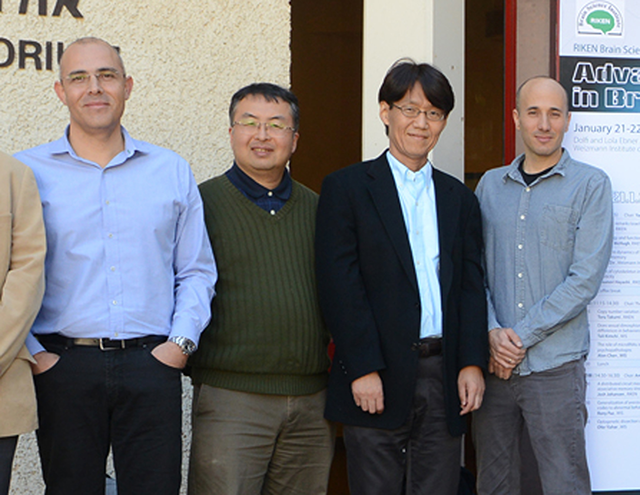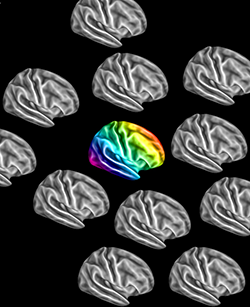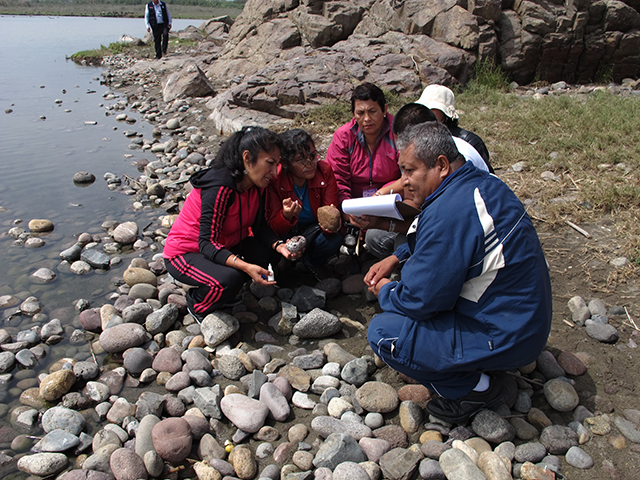Israel-Japan Conference to Foster Cooperation in Brain Research; Autistic Brains Go Their Own Way; Thinking Locally
Israel-Japan Conference to Foster Cooperation in Brain Research

Japanese and Israeli scientists at the Advances in Brain Sciences conference
Following the visit of Japan’s Prime Minister, Shinzo Abe, to Israel early in the week of January 18th, the end of the week held a visit by a group of leading Japanese scientists to Rehovot, Israel. The Advances in Brain Sciences conference the scientists attended was jointly hosted by the Weizmann Institute of Science in Rehovot and the RIKEN Brain Science Institute in Japan. The parallels were more than incidental: Abe and Israel’s Prime Minister, Benjamin Netanyahu, discussed furthering business, research, and development contacts between the countries; Weizmann and RIKEN researchers are already working to advance scientific collaboration between the two institutes and the two countries.
The Weizmann Institute’s Dr. Ofer Yizhar, one of the conference organizers, is currently involved in a collaborative research project with RIKEN researcher Toru Takumi. “Takumi creates mice that have a genetic defect which mimics autism, while my optogenetics lab can work with these mice, turning neurons in the brain ‘on’ and ‘off’ with light. Together, we hope to discover how autistic spectrum disorder develops in the brain and what neural mechanisms are involved in autistic behaviorisms,” says Dr. Yizhar.
Over the two days of the conference, speakers touched on many different aspects of brain research: Yasunori Hayashi of RIKEN, for example, gave a talk on the roles of the cells’ internal cytoskeleton in maintaining the plasticity of the synapses between certain brain cells. The Weizmann Institute’s Prof. Rony Paz discussed his findings that show how our tendency to overgeneralize may sometimes work against us, such as when memories of traumatic events turn into post-traumatic disorders. The keynote speaker, Weizmann’s Prof. Shimon Ullman, spoke about visual recognition – a subject that crosses the boundaries between neuroscience and artificial intelligence. Prof. Ullman, who has worked with RIKEN’s Dr. Manabu Tanifuji for a number of years, says: “Scientific and personal connections have deepened over the years, and we are currently planning the next steps of joint work in the future.”
Informal events and visits to labs during the two-day conference gave the researchers from the two countries an opportunity to meet and discuss ideas for future research directions. “RIKEN is the premier brain research center in Japan, and one of the best in the world,” says Prof. Yadin Dudai, one of the conference organizers. “We see that much of Weizmann Institute research complements that being done in Japan; there is great potential to work together in many areas. This can benefit both sides, and we hope to see more cooperation in the future.”
Autistic Brains Go Their Own Way
Autism spectrum disorder (ASD) has been studied for many years, but there are still more questions than answers. For example, some research into the brain functions of individuals on the autism spectrum have found a lack of synchronization between different parts of the brain that normally work in tandem. But other studies have found the exact opposite – over-synchronization in the brains of those with ASD. A new study by Avital Hahamy and Prof. Rafi Malach of the Weizmann Institute’s Department of Neurobiology, working with Prof. Marlene Behrmann of Carnegie Mellon University, Pittsburgh, recently published in Nature Neuroscience, suggests that the various reports – of both over- and under-connectivity – may, in fact, reflect a deeper principle.

To investigate the issue of connectivity in ASD, the researchers analyzed data obtained from functional magnetic resonance imaging (fMRI) studies conducted while the participants were at rest. These had been collected from a large number of participants at multiple sites and handily assembled in the Autism Brain Imaging Data Exchange (ABIDE) database. “Resting-state brain studies are important,” says Hahamy, “because that is when patterns emerge spontaneously, allowing us to see how various brain areas naturally connect and synchronize their activity.” A number of previous studies in Prof. Malach’s group and others suggest that these spontaneous patterns may provide a window into individual behavioral traits, including those that stray from the norm.
In a careful comparison of the details of these intricate synchronization patterns, the researchers discovered an intriguing difference between the control and ASD groups: The control participants’ brains had substantially similar connectivity profiles across different individuals, whereas those with ASD showed a remarkably different phenomenon. These tended to display much more unique patterns – each in its own, individual way. The researchers realized that the synchronization patterns seen in the control group were “conformist” relative to those in the ASD group, which they termed "idiosyncratic."
The researchers offer a possible explanation for differences between the synchronization patterns in the autism and control groups: They might be a product of the ways in which individuals in the two groups interact and communicate with their environment. Hahamy: “From a young age, the average, typical person’s brain networks get molded by intensive interaction with people and the mutual environmental factors. Such shared experiences could tend to make the synchronization patterns in the control group’s resting brains more similar to each other. It is possible that in ASD, as interactions with the environment are disrupted, each one develops a more uniquely individualistic brain organization pattern.”
The researchers emphasize that this explanation is only tentative; much more research will be needed to fully uncover the range of factors that may lead to ASD-related idiosyncrasies. They also suggest that further research into how and when different individuals establish particular brain patterns could help in the future development of early diagnosis and treatment for autism disorders.
Prof. Rafael Malach’s research is supported by the Murray H. and Meyer Grodetsky Center for Research of Higher Brain Functions, which he heads, and the Friends of Dr. Lou Siminovitch. Prof. Malach is the recipient of the Helen and Martin Kimmel Award for Innovative Investigation, and is the incumbent of the Barbara and Morris L. Levinson Professorial Chair in Brain Research.
Thinking Locally
An educational module developed at the Weizmann Institute will be included in the Peruvian science curriculum

Peruvian teachers in the Blue Planet workshop
Peru’s Ministry of Education recently announced that it will be adopting the Blue Planet educational program, which was developed at the Weizmann Institute of Science, into its schools’ curricula. Blue Planet, which takes a hands-on approach to learning about the water cycles on our planet, has been recognized by UNESCO as a model program for environmental education. The project’s developer, Prof. Nir Orion of the Institute’s Department of Science Teaching, was recently in Peru leading a workshop for teachers.
“Learning is a natural process,” says Prof. Orion, “an instinct that almost all animals are born with. But like all instincts, it only comes into play when it is needed. Many children do not learn well in school because it is a system that is created to meet the needs of the system itself, and not those of the child.” Prof. Orion believes that the learning instinct might be reawakened by creating a connection between the student’s world and the subject matter. Thus, his approach to teaching involves, among other things, an exploration of both the natural and human environments that exist beyond the walls of the classroom. Lessons learned this way, which have some significance for the student, will be internalized and thus “truly learned.”
Although the basic principles of the Blue Planet program remain constant, the change of location means that Prof. Orion goes out to survey each region, constructing a local narrative to guide the lesson plan. His “working files” tell the stories of Argentina, Chile, the U.S., India, Portugal, and, of course, Israel. In Peru, for example, he found that, even though the country receives a large amount of rainfall, the perception is that the region suffers from a water shortage. So the workshop focused, among other things, on the topic of drainage basins in populated areas. The Blue Planet approach is a part of the science curriculum “thinking science – understanding environment.”
Prof. Orion’s approach includes both in-classroom and out-of-classroom learning. “Some things cannot be taught in a deep way within the classroom,” he says. “When we use the outside environment properly, curiosity and interest arise. That is when the student starts to ask questions.” The ultimate goal is to give the students the tools to think analytically, to take in their field and lab observations and arrive at conclusions, and to present their findings to others. “If they gain the ability to integrate data, process it logically to arrive at knowledge, and present this knowledge orally and in writing,” says Prof. Orion, “they will be set for life.”
